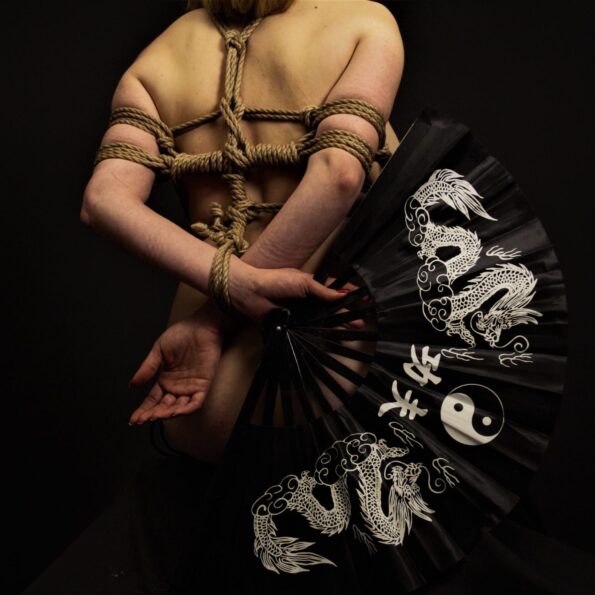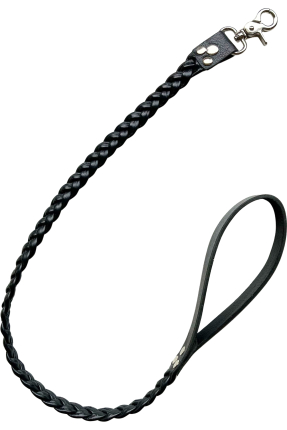Shibari and Kinbaku are not merely erotic or sexual practices. On the contrary, this art of restraint offers a beautiful, functional, and safe experience that encompasses various aspects. The application of this art demonstrates a deep commitment to Japanese culture and traditions. Viewed from this perspective, Shibari is seen as a ritual; the basic movements of wrapping and knotting ropes bear similarities to fundamental movements in Japanese calligraphy practice, known as shodo.
At the core of this art lies an exchange of emotion and energy between the one binding and the one being bound. Known as “ki hairimasu” this transmission is a cornerstone of the Shibari experience. Every movement by the binder’s hands provides the bound individual with a touch full of emotion.
Knots represent both functional and artistic aspects of this art. Referred to as “kazarinawa” these knots are skillfully used to ensure the safety of the bound individual while adding visual richness. The wrapping of ropes emphasizes the intricacies and aesthetics of the binding process.
It is crucial for the binder to control the ropes skillfully and avoid unnecessary steps through ergonomic movements, known as “sabaku“. These movements not only ensure the comfort and safety of the bound individual but also maintain the flow and aesthetics of the art.
The binder must understand how to adapt to the internal rhythm of the bound individual during the binding process. The concept of “merihari” involving adjusting pressure and creating intelligent variations, enhances the comfort and safety of the bound individual. This personalizes the Shibari experience and fosters deep emotional connections.
Lastly, timing and distance, especially in suspended positions, are essential. The concept of “maai” or distance ensures maintaining the right distance between the bound individual and the binder, influencing the flow of the Shibari experience.
Shibari and Kinbaku offer a profound art and experience beyond mere physical practice. Delving into the intricacies of this art can provide not only physical pleasures but also deep emotional bonds and aesthetic experiences. This ritual is woven with an exchange of emotion and energy between the bound and the binder, with each wrap and knot of the rope strengthening this profound connection.
“Deep Emotion” and Its Contexts
In Shibari, terms like merihari (減り張り), urawaza (裏技), sabaku (捌く), foster a deep connection between the binder and the bound:
Merihari and Emotional Bond: The term merihari denotes the adjustment of pressure applied by the rope during binding. This reflects the binder’s attention and sensitivity to the bound individual’s body, fostering a sense of safety and protection. The bound individual may feel physically secure and protected through the binder’s careful and sensitive touches, fostering trust and establishing an emotional bond.
Urawaza and Creative Binding: Urawaza refers to techniques that go beyond traditional methods, showcasing the binder’s creativity and uniqueness. The binder’s innovative and creative approach can have an emotional impact on the bound individual, making them feel special and understood, thus creating an emotional bond.
Sabaku and Physical Connection: Sabaku signifies how the rope interacts with the body, reflecting the binder’s careful and skillful handling of the rope. The binder’s attentive and sensitive touches can enhance the bound individual’s physical sensations and create an emotional connection. The bound individual may feel understood and valued, appreciating the binder’s attention and sensitivity.
Traditional Ritual and Flow
These terms highlight that Shibari is not just about physical interaction but also about establishing deep emotional connections. The emotional bond between the binder and the bound, comprising feelings of trust, respect, understanding, and acceptance, enhances the Shibari experience, making it more profound and meaningful.
Traditional Ritual and Flow These terms indicate that Shibari is not merely a physical interaction but also has the potential to establish a deep emotional connection. This emotional bond between the binder and the bound can encompass feelings such as trust, respect, understanding, and acceptance, enriching the Shibari experience and making it more profound and meaningful.
It’s important to emphasize that Shibari or Kinbaku is not solely an erotic or sexual practice. Indeed, this art form encompasses a broad spectrum, offering a beautiful, functional, and safe form of restraint. The practice of this art can include a dedication to Japanese traditions and specific rituals. From this perspective:
Ritual and Tradition: Shibari or Kinbaku can be viewed as a ritual. The wrapping, knotting, and binding process bear aesthetic and ritualistic similarities to movements used in Japanese calligraphy practice.
Emotion and Energy Transfer: There should always be an exchange of emotion and energy between the binder and the bound. This imbues the art with depth and makes the bonds more meaningful.
Knots and Aesthetics: Knots should be considered not only for their functionality but also for their quality and aesthetics. These knots not only ensure safety but also contribute visually to the overall appeal.
Ergonomic Movements and Control: The binder should skillfully control the ropes with ergonomic movements, avoiding unnecessary steps. This ensures the comfort and safety of the bound individual while maintaining the flow and aesthetics of the art.
Harmony with Internal Rhythm and Merihari: The binder should adapt to the internal rhythm of the bound individual during the binding process. Merihari, involving adjusting pressure and intelligently applying variations, enhances the comfort and safety of the bound individual.
Timing and Distance: Timing, especially in suspended positions, and maintaining the right distance based on the binding are crucial. The concept of “maai” or distance ensures the proper distance between the bound individual and the binder, facilitating the flow of the Shibari experience.
These elements underscore that Shibari or Kinbaku is more than just a physical practice; it is a profound art and experience. Delving into the depths of this art form can offer not only physical pleasures but also deep emotional connections and aesthetic experiences.




